1,067 BASIC CHARACTERS
and
Elements of the Writing System

YĪ (YÍ, YÌ), one. ONE radical (2) [A] L1
一 “one,” 二 “two” (5, p. 2), and 三 “three” (6, p. 2) are probably the three simplest symbol characters in the language. As a radical this form is often called “the horizontal stroke.” 一 is generally pronounced yí before a word in the fourth tone, and yì before words in the first, second, or third tones.
一月 yīyuè January
唯一 wéiyī only

PIĚ, left-falling stroke. LEFT radical (4)
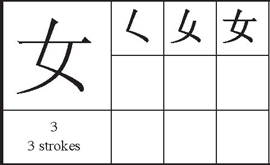
NǙ, woman. WOMAN radical (73) [A]
女 is a picture—a rough stick drawing of a woman (with legs modestly crossed, say commentators). It occurs as an independent character and means “woman” or, occasionally, “daughter.”
女孩 nǚhái girl
女性 nǚxìng female
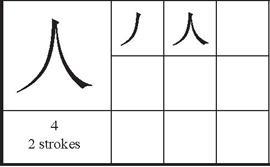
RÉN, human being, person. PERSON radical (old style: MAN radical) (23) [A] L1
Rén is a picture—a rough stick drawing of a human being. It occurs as an independent character. Learn to distinguish rén from 入 rù, “enter” (204, p. 41)—although both are now the same radical in most modern dictionaries.
女人 nǚrén woman, female [B] L2

ÈR, two. TWO radical (11) [A] L1
二月 èryuè February
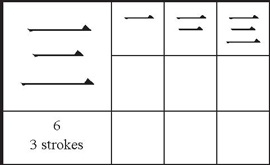
SĀN, three [A] L1
三十 sānshí thirty
三十一 sānshíyī thirty-one

SHÍ, ten. TEN radical (12) [A] L1
The “ten” radical is simply an arbitrary symbol for the number “ten.”
十一 shíyī eleven; October 1, National Day (People’s Republic of China)
十二 shíèr twelve
二十 èrshí twenty
二十一 èrshíyī twenty-one
三十 sānshí thirty

JIŌNG, borders. BORDERS radical (19)
Jiōng, “borders,” is not in use as an independent character. It is, however, the radical under which about 10 common characters are classified in modern dictionaries or in the indexes to modern dictionaries arranged phonetically, so the student should learn it. Distinguish from “gate” (25, p. 6).

WÉI, to surround. SURROUND radical (59)
Dictionaries sometimes gloss this character as “the old form of 围” (“to go around; circumference,” 968, p. 194). 囗 is the radical of over 20 modern characters and should be learned.
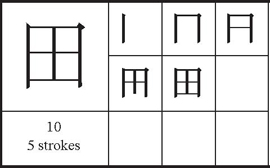
TIÁN, field; a family name. FIELD radical (142) [B]
The “field” radical is a picture of the typical Chinese (and East Asian) field—a large field divided by raised paths into small paddies.
田地 tiándì field; land
农田 nóngtián farmland
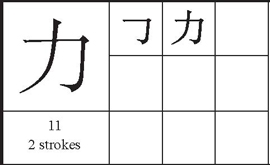
LÌ, strength. STRENGTH radical (28) [A]
This is a picture of a plow, thus strength. The student should distinguish “strength” from the “knife” radical 刀 (131, p. 27).
人力 rénlì manpower, labor power [C]
力气 lìqì strength L4
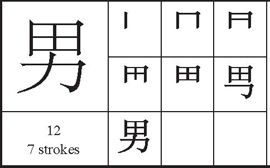
NÁN, male [A]
According to the classic dictionary Shuō wén jiě zì, 男 is a meaning-meaning compound: “it’s the males who use their strength 力 in the fields 田.”
男人 nánrén man, male [B] L2
男女 nánnǚ men and women
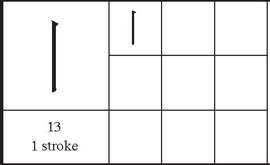
SHÙ, downstroke. DOWN radical (3)
Anciently, the “down” radical was pronounced “gǔn,” but now everybody reads it as “shù,” meaning “the vertical stroke.” Not in use now as an independent character, it is the radical of six common modern characters.

RÉN, man. SIDE-MAN radical (21)
Traditional dictionaries classify this form as a special case of the “human being, person” radical (4, p. 1), but this form, in its functions in the writing system, in various cases seems to mean “male human being.” See, for example, 24, p. 5. Not independent, but an important radical.
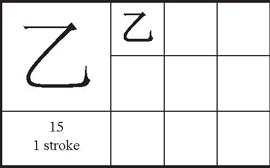
YǏ, twist; the second “heavenly stem.” TWIST radical (7). Used to enumerate headings in an outline, like “B”—second letter of the Western alphabet. L5
The form 乙 and the form  are variant forms of this radical. In early texts it means “fish guts” and may have been a picture. On “heavenly stems,” see Lin Yutang’s Dictionary 1451f.
are variant forms of this radical. In early texts it means “fish guts” and may have been a picture. On “heavenly stems,” see Lin Yutang’s Dictionary 1451f.
乙 醇 yǐchún alcohol

No pronunciation. GRASS radical (50)
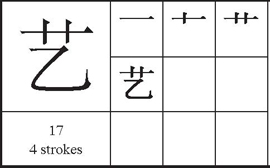
YÌ, skill; art [A]
This character is a sound-meaning compound. The “twist” radical suggests the sound, and the “grass” radical suggests the meaning—originally related to gardening.
艺术 yìshù art L4
园艺 yuányì the art of gardening
藝
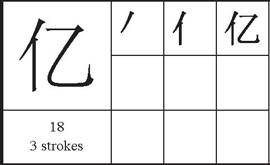
YÌ, a hundred million [A] L4
十亿 shíyì one billion
億

XĪN, heart. SIDE-HEART radical (41)
This does not occur as an independent character; the independent form of “heart” is 87, p. 18. Serious students of Chinese culture should note that “heart” is often given a double gloss: “heart-mind,” as if they were one thing.

YÌ, to remember [B]
This character is a sound-meaning compound. The “twist” radical suggests the sound, and the “heart” radical suggests the meaning—you will always be in my heart.
记忆 jìyì memory
回忆录 huíyìlù memoirs
憶
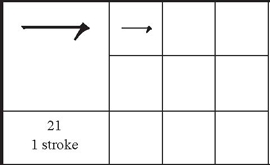
No pronunciation. Radical (5) “Back-turned stroke.”
乛 is the radical in six or so common modern characters. In two of these, it appears with a slanted horizontal part and a longer vertical part, as in the next character.
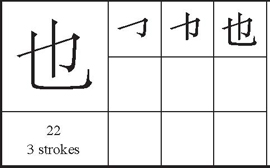
YĚ, also [A] L2
The history of 也 is very complicated, involving the confusion of at least three different characters. The radical is 乛 (21, above).
也许 yěxǔ perhaps; maybe L4
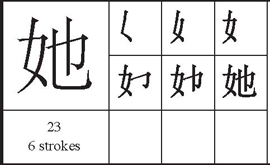
TĀ, she, her [A] L1
This character is a sound-meaning compound. The “woman” radical suggests the meaning, and 也 (22, above) once suggested the sound—although it is not now such a good phonetic. Compare with 24, below. This character is created more recently under the influence of European languages with gendered pronouns.
她们 tāmen they; them (feminine) [A] (see 26)
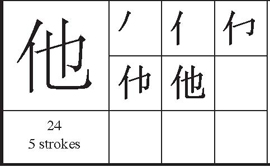
TĀ, he, him [A] L1
他 is a sound-meaning compound. The “man” radical suggests the meaning, the right half, 也 (22, above) at one time suggested the sound. Note the logic of the writing system: the “man” radical occurs in the character for “he, him,” the “woman” radical in the character for “she, her.”
他们 tāmen they; them (masculine and/or feminine) [A]
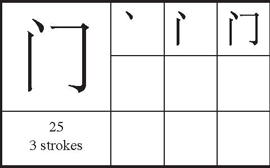
MÉN, gate. GATE radical (46) [A] L2
A picture. Its resemblance to a gate may not be clear, but the traditional form (see lower right-hand corner of this frame) clearly resembles the swinging saloon doors in old Westerns. It occurs as an independent character and means “gate, door, entrance.” Distinguish from “borders” (8, p. 2).
大门 dàmén gate
门卫 ménwèi entrance guard; doorkeeper
門

MÉN, pluralizing suffix for pronouns and for certain nouns [A]
Mén is used with nouns and pronouns referring to people: the “side-man” radical for meaning; mén (25, above) for sound.
她们 tāmen they, them (feminine) [A]
他们 tāmen they, them (masculine and/or feminine) [A]
們
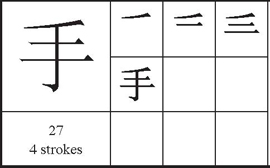
SHǑU, hand. HAND radical (111) [A]
Shǒu often occurs as an independent character meaning “hand”; it may also occur as a part of characters. The form 扌 (see 28, below) was considered a variant of 27 here, but it is now a separate radical (55) and may be called “side-hand” to distinguish it.
手指 shǒuzhǐ finger L5
手套 shǒutào gloves L5

SHǑU, hand. SIDE-HAND radical (55)
Traditionally, this form was considered a variant of the “hand” radical (27, above), but in modern dictionaries, it is classified as a separate radical. The form here (扌) does not appear as an independent character. Distinguish from “thumb” 寸 (237, p. 48) and from “then” 才 (689, p. 138).

YÌ, dart. DART radical (56)
The “dart” radical is a picture. Han-Ying Cidian defines it as “a retrievable arrow with string attached” and calls it “bookish.” Compare the “lance” radical (30, p. 7) and learn to distinguish “lance” from “dart.”

GĒ, lance. LANCE radical (101)
The “lance” radical is a picture. Note that “lance” has one more stroke than “dart,” at the bottom. In museums you can see that the old weapon called “gē” had a blade like this at the lower end. The weapon is also sometimes called a “dagger-ax.”
戈壁 gēbì desert
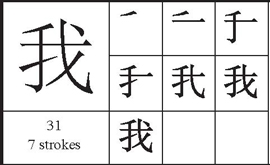
WǑ, I, me [A] L1
Originally the name of a weapon similar to a lance, current meaning by sound-loan. The student should learn to distinguish 我 wǒ from 找 zhǎo “look for” (32, below). Wǒ is “hand” + “lance”; zhǎo is “side-hand” + “lance.”
我们 wǒmen we, us [A] L1

ZHǍO, to look for; to visit; to give change [A] L2
The student should distinguish zhǎo from wǒ 我 (31, above).
寻找 xúnzhǎo to look for L5
找到 zhǎodào to find

TÓU, lid. LID radical (9)
Originally, tóu had a more general meaning: “above; a thing that goes on top of something else, covering.” It may be easier to remember as “lid” because it looks like a lid. Distinguish from the “crown” radical 冖 (36, p. 8), and the “roof” radical 宀 (40, p. 9). Not used independently, tóu is the radical in over 20 common characters.

TǓ, earth. EARTH radical (49) [B]
This appears to be a picture of a cross stuck into the earth (“The axis mundi!” say some scholars). Note this is not its etymology though. It occurs as an independent character and means “earth, soil.” Distinguish from the character 士 shì, “knight, scholar” (35) in which the bottom line is shorter than the upper line, although they are the same modern radical.
土人 tǔrén a native, an aborigine
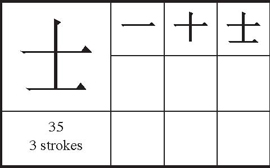
SHÌ, knight; scholar. KNIGHT form of the EARTH radical (34, above) [B]
Of disputed etymology. (MN) A shì took ten (十) things and organized them into one (一) for his lord.
人士 rénshì personage, notable person [C]
女士 nǚshì polite address for women, especially professionals; Ms. [B] L5

MÌ, crown. CROWN radical (18)
Mì had a general meaning of “to cover, a cover”—crown by metonymy (and as a useful mnemonic). Not used independently now, it appears at the top of characters. Distinguish from the “roof” radical 宀 (40, p. 9) and from the “lid” radical 亠 (33, p. 7).

XIǍO, be small, be little. SMALL radical (79) [A] L2
Variant:  . Originally, this radical was three dots to suggest “small.” Two of the dots remain, but the center dot has been replaced by a downstroke with a little hook on the end, made by an elegant movement of the wrist with a brush (ballpoint pens won’t do it).
. Originally, this radical was three dots to suggest “small.” Two of the dots remain, but the center dot has been replaced by a downstroke with a little hook on the end, made by an elegant movement of the wrist with a brush (ballpoint pens won’t do it).
小孩 xiǎohái children
小妹 xiǎomèi younger sister
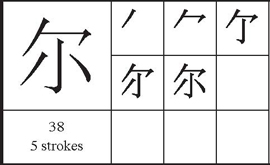
ĚR, you, your; -ly, -like; that (opposite to “this”) [C]
This character has a complicated history. It came to mean “you” by sound-loan. Bookish.
偶尔 ǒuér sometimes; on occasion L4
爾
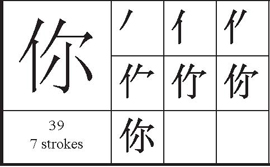
NǏ, you [A] L1
Nǐ and ěr (38, above) most likely stood for cognate words meaning “you.” Nǐ is ěr reclarified with the “man” radical.
你们 nǐmen you (plural) [A]
你好 nǐhǎo How’re you?

MIÁN, roof. ROOF radical (45)
The character is a picture. Suggest remembering the top stroke as a chimney. The student will want to distinguish “roof” from “lid” 亠 (33, p. 7) and from “crown” 冖 (36, p. 8). Not an independent character, mián is the radical of over 50 common modern characters.

BǏ, ladle. LADLE radical (39)
The character is a picture.
匕首 bǐshǒu dagger
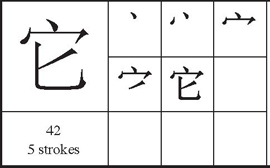
TĀ, it [A] L2
Karlgren sees this as originally a pictograph meaning “cobra” (Analytic Dictionary 1011), later corrupted into “roof” over “ladle,” and as coming by sound-loan to mean “the other, another, it.”
它们 tāmen they, them (not human beings) [A]

LE; a particle: after verbs or sentences; le basically means “changed status” or “completed action”; LIǍO, to finish, to conclude; to understand [A] L1
Students who want a fuller account of this busy little particle should consult the index to Chao Yuen Ren, A Grammar of Spoken Chinese (1968) (26 references).
好了 hǎole finished
懂了 dǒngle understood
了解 liǎojiě to understand L3
暸 (for liǎo)

ZǏ, child; first of the twelve “earthly branches” (used in enumerations and to name two-hour periods of the day). CHILD radical (74) [A]
子 is a picture. In older forms, it quite clearly resembles a child. 子 occurs often independently and as a suffix to many nouns. “Earthly branches”: see Lin Yutang’s Dictionary 1451f.
儿子 érzi son L1
孩 子 háizi child L2

HǍO, be good, be well; HÀO, to consider good; to like, to love [A] L1
好 combines meanings. “Woman” beside “child” suggests “goodness, well-being, something desirable.”
好人 hǎorén good person; healthy person; a “good guy” who tries to get along with everybody, often sacrificing principle to do so.

SĪ, be selfish, be private. NOSE radical (37)
The radical was originally a picture of a nose. Pointing at one’s nose to refer to oneself is a common practice in China. Dictionaries often note that this is the original form of 私, “private, selfish” (Pt. 2, p. 216a)

YĀO, coil; be immature, be tender, be little. COIL radical (76)
The “coil” radical was originally a picture of a coil of silk thread. Learn to distinguish “coil” from the “nose” radical 厶 (46, above), and from the “silk” radical 纟 (48, below).

SĪ, silk. SILK radical (77)
In seven common modern characters, the “silk” radical appears in its more complex, traditional form (see below, this frame). Lèi (49, below) is one example. This happens when the “silk” radical is at the bottom, rather than at the side, of the character. It’s done, no doubt, for aesthetic reasons.
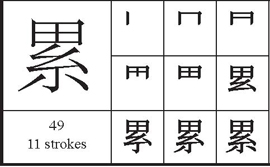
LÈI, be tired; LĚI, pile up; be repeated [A] L2
In ancient China, the men’s main work was in the fields; the women’s main work was sericulture (silk-farming). This is a good mnemonic to remember this character. (Original meaning is “to pile up.”)
好累 hǎolèi be very tired

CHÌ, step. STEP radical (62)
From a picture of cross roads, the current radical form is corrupted. Suggest seeing it as “sideman” (14, p. 3), to which a stroke has been added—to suggest movement, a step taken. The “step” radical occurs often in characters for action or movement.
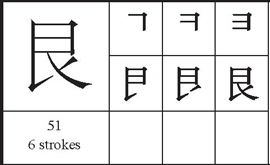
GÈN, be stubborn; be blunt; be tough, leathery (of food or people). STUBBORN radical (184)
In early texts,
艮 is clearly a picture of a man with a big, staring eye—an obstinate type, an insolent fellow. Now the spoken word gèn is dialect—used in certain localities, but not part of modern standard Chinese. Distinguish from 良 (412, p. 83).

HĚN, very [A] L1
This character is a sound-loan for hěn, “very.” Originally, it stood for a word that meant “to act stubborn, to resist”—a word that probably was cognate with gèn (51, above). The “stubborn” radical was reclarified with the “step” radical, and sometime later the character was borrowed for hěn, “very.”
很好 hěnhǎo very good, very well

KǑU, mouth; a measure for human beings. MOUTH radical (58) [A] L3
口 is a picture. It also occurs as an independent character and means “mouth.”
人口 rénkǒu population [B] L5
口子 kǒuzi (noun) hole, opening, cut, rip
三口人 sānkǒu rén three people

HUǑ, fire. FIRE-DOTS radical (80)
This is a picture of a fire burning on the ground. It occurs only as a part of characters. There is also a “fire” radical (see 295, p. 60). Traditionally, “fire-dots” appeared in characters for creatures such as “horse,” “bird,” “fish,” “bear,” “swallow (bird),” “crow,” etc. However these are stylized body parts and have no connection with fire.
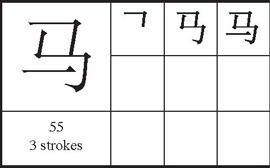
MǍ, horse; a family name. HORSE radical (75) [A] L3
A picture: the traditional form below is more representational. In modern times, “fire-dots” is abbreviated to a single horizontal stroke. As Nietzsche said, “Nowadays, everybody’s in a big hurry.”
小马 xiǎomǎ pony
马力 mǎlì horsepower [D]
馬
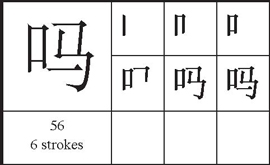
MA; a particle [A] L1: at the end of a sentence, it makes the sentence into a question; it may also appear within a sentence after the subject or topic to mark it off: “X 吗 … (As for X …).”
吗 is a sound-meaning compound, with the “mouth” radical warning, as it often does, that the other part is phonetic, not semantic.
嗎
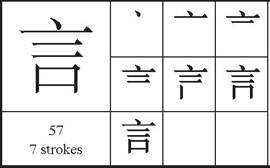
YÁN, word, words; family name. WORDS radical (185) [A]
Notice the “mouth” in “words.” Suggest taking the other lines as words pouring from the mouth, or “motion lines” to suggest the mouth moving. Yán often occurs as an independent character and means “words, speech.”
语言 yǔyán language
文 言 wényán classical Chinese
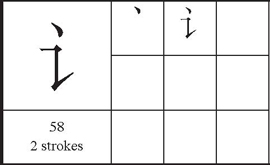
YÁN, word, words. SIDE-WORDS radical (10)
This character is the modern abbreviation for 57, above. The “words” radical (57) is the radical in about four modern characters, “sidewords” in dozens of characters.

ZHUĪ, dove. DOVE radical (208)
Dictionaries often define zhuī as a “short-tailed bird.” In some ancient texts, it specifically means “dove.” The older forms of the character were clearly a picture of a bird. This character does not exist as an independent character.
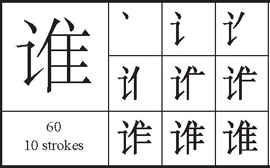
SHÉI, who? whom? Also SHUÍ [A] L1
This character is probably a sound-meaning compound. Zhuī (59, p. 12) is supposed to suggest the sound.
誰

DÀ, be big. BIG radical (52) [A] L1
大 is a man with arms extended: “big.” Dàxiǎo, size. (Abstract nouns in Chinese are often antonyms combined, as if to say “the big and the small of it, the size”; duōshǎo “many/ few: how many” (see 380, p. 77); qīngzhòng “light/ heavy: weight” (Pt. 2, p. 218a); kuānzhǎi “broad/ narrow: width” (950), etc.)
大哥 dàgē elder brother
大学 dàxué university
大夫 dàifū doctor L4
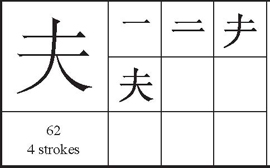
FŪ, husband, “big man” [A]
A picture of a man with a hairpin—commonly seen in ancient China.
大夫 dàifu medical doctor (note change of pronunciation for “大” dà → dài) [A] L4
夫人 fūren Mrs., Madam [A] L6
马夫人 Mǎ fūren Mrs. Ma, Madam Ma

TIĀN, heaven, God, day, natural. HEAVEN radical (90); see 66, p. 14 [A]
天 is said to be a picture of an anthropomorphic deity. The form 夭 yāo “be gentle, tender,” historically distinct from 天, is now, as radical, considered a variant of 天.
天天 tiāntiān every day
天子 tiānzǐ the emperor
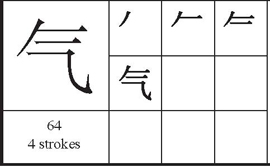
QÌ, breath, vapors, exhalation, animus, energy, soul. BREATH radical (109) [A]
The character is a picture of breath passing off in waves.
空气 kōngqì air L4
气 球 qìqiú balloon
氣

ZHÚ, bamboo. BAMBOO radical (178) [B]
This character is a good picture of the slender, drooping leaves of the bamboo. The form is modified (slightly) when this radical appears as a part of characters (see 66, below).
竹子 zhúzi bamboo [B] L5
竹马 zhúmǎ stick used as a toy horse
青梅竹马 qīngméizhúmǎ lovers who know each other from childhood

XIÀO, to laugh, smile; to ridicule [A] L2
One scholar says, “When bamboo takes the wind, it leans back gently like a man who laughs.” That may be better as a mnemonic than as a philological explanation.
好笑 hǎoxiào be easy to laugh at, be funny, be ridiculous
笑 星 xiàoxīng star comedian

ÉR, child, son; R, suffix to nouns (rarely to verbs). SON radical (29) [A]
Anciently, this radical was recognized as the “legs” radical. Its use now, however, is primarily as the short form for 兒 “son, child,” 兒 being a picture of a child with open fontanel.
儿子 érzi son [A] L1
儿女 érnǚ sons and daughters, children [C]
兒

WĀNG, be lame; YÓU, still; a family name. LAME radical (53)
This is a picture of two legs, one shorter than the other to suggest lameness. The horizontal stroke serves to emphasize the unequal length of the two legs. In independent use only as a variant for 尤 (394, p. 79), whence the pronunciation yóu. Distinguish from 大 (61, p. 13) and 无 (69).

WÚ, to lack, not to have; not... (negator of verbs) [B] L4 Distinguish from 元 (89, p. 18).
无人 wúrén unmanned; depopulated; self-service
无力 wúlì lack strength, feel weak; be incapable of . . .
无大无小 wúdàwúxiǎo regardless of size, not knowing one’s social status
無

XĪN, be bitter, be toilsome; the eighth “heavenly stem” (used to enumerate items in an outline, like “H”—eighth letter of the Western alphabet); family name. BITTER radical (186) [A]
For more on the “heavenly stems,” see Lin Yutang’s Dictionary 1451f. Distinguish from 幸 “be lucky” (next entry).
(MN) A standing 立 ten 十 is toilsome
辛苦 xīnkǔ hard, painstaking L4

XÌNG, lucky [A]
The student should learn to distinguish this character from the “bitter” character (70, above). “Lucky” has “earth” on top, “bitter” has “lid” on top.
幸福 xìngfú happiness L4
幸运 xìngyùn lucky L5

WÁNG, king, family name. KING radical (88) [B]
One explanation of wáng is pretty philosophical (even Confucius endorses it). As one scholar says: “There are the three —Heaven, Earth, and Man: the mediator between them is the king.” However, this is wrong, as the oracle bone script clearly shows wáng being a picture of an axe, a king of violence if you will.
国王 guówáng king

ZHǓ, dot. DOT radical (1)
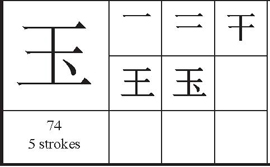
YÙ, jade. JADE radical (131) [B]
Originally this character was a picture of three disks of jade (the horizontal strokes) strung together on a string (the vertical stroke). The dot may have been added to distinguish “jade” from “king” (72, above).
玉手 yùshǒu (bookish) a very white, beautiful hand

ZHǓ, lord, host; principal; to indicate [A]
Zhǔ (73, p. 15) gives the sound; “king” suggests the meaning. This is the phonetic in several common characters (see 76, 78, 79 below).
主人 zhǔrén host; landlord; master [B] L5
主力 zhǔlì main force (of a team, crew, army, factory shift, etc.) [C]

ZHÙ, to live, to stay; to stop; verb-ending [A] L1
This character is a sound-meaning compound. The right part suggests the sound, and the “side-man” radical suggests the meaning—a man stays somewhere.
As verb-ending, 住 carries the idea of “stop, stump, stymie; be stopped/stumped/stymied.” See Chao Yuen Ren’s Grammar, 464-65. See also 问住 (255, p. 52) and 难住 (488, p. 98).
住所 zhùsuǒ residence
住址 zhùzhǐ address
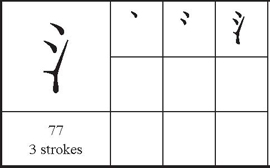
SHUǏ, water. The “THREE-DOTS-WATER” radical (40).
The other form of the “water” radical, which may occur independently, is 473, p. 95. This radical does not occur as an independent character. It often appears as part of characters for liquids.
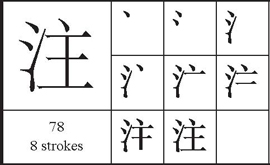
ZHÙ, to comment on, to annotate; to concentrate on; note, commentary; to pour into; bet, stake; a measure for business transactions or for sums of money [A]
This character is a sound-meaning compound. The right part suggests the sound, and the “three-dots-water” radical suggests the meaning.
注意 zhùyì pay attention to
注射 zhùshè injection
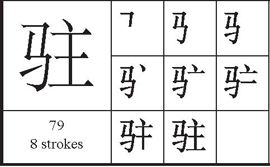
ZHÙ, to stop; be stationed at, posted to [C]
This character is a sound-meaning compound. The right part suggests the sound, and the “horse” radical suggests the meaning—originally a stopping horse.
驻军 zhùjūn station troops
駐

MÙ, tree; be dull, stiff, “wooden” (metaphorically). TREE radical (94) [B]
The “tree” radical is a picture of a tree. As a radical, it often occurs in characters for objects made of wood. Distinguish it from 禾 “grain” (81, below), 米 “rice” (126, p. 26), and 采 “sift” (620, p. 125).
土木 tǔmù building and construction
木讷 mùnè honest and slow witted
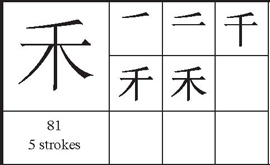
HÉ, grain, especially rice. GRAIN radical (149) [D]
Note the similarity between “grain” and 木 “tree” (80, above). “Grain” has the left stroke across the top to represent the head of ripened grain. Distinguish “grain” from 采 “sift” (620, p. 125).
禾苗 hémiáo seedlings of cereal
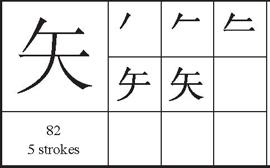
SHǏ, arrow; to vow. ARROW radical (148)
The character is a picture. The point of the arrow is at the top, and the feathers and notch are at the bottom. Distinguish from shī 失 “to misplace, lose; fail, be defeated” (83, below).
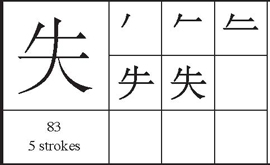
SHĪ, to misplace, lose, fail; be defeated [B]
Distinguish from 矢 “arrow,” above.
丢失 diūshī to lose sth
失身 shīshēn to lose one’s virginity

ǍI, be short (not tall) [A] L3
矮 is composed of “arrow” 矢 + “grain” 禾 + “woman” 女 —all things which, within their classes, are generally shorter: arrows than spears, grain than trees, women than men. A useful mnemonic, but not necessarily the etymology.
矮子 ǎizi short person, dwarf
矮小 ǎixiǎo be diminutive, under-sized
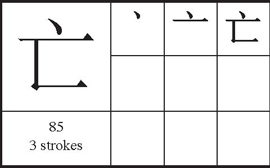
WÁNG, to flee, to hide; be gone; to die; be subjugated. FLEE radical (43) [C]
What is now “lid” (33, p. 7) was once 入 “enter” (204, p. 41) or 人 “person” (4, p. 1)—somebody entering a corner or nook to hide in it. Basic meaning, then, is “to flee, to hide.” The other meanings are derived.
死亡 sǐwáng death, to die L6
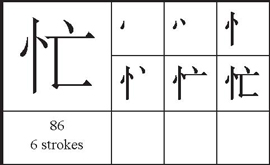
MÁNG, be busy [A] L2
忙 is supposed to be a sound-meaning compound. Wáng (85, above) supposedly suggests the sound, and “heart” suggests the meaning.
(MN) So busy! The heart wants to flee!
忙碌 mánglú be busy L6
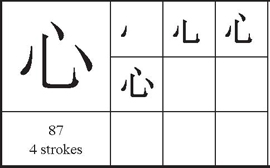
XĪN, heart. HEART radical (81) [A]
In the old form of
心, it is easy to see the picture of a heart. In this form, the “heart” radical occurs as an independent character and as an element at the bottom of characters. Compare with 19, p. 4.
小心 xiǎo xīn Be careful! [B] L4
无心 wúxīn not feel like it, not be in the mood for; unintentionally

NÍN, you [A] L2
您 is deferential, used to address elders and superiors. Note that the top of this character is 你 “you” (39, p. 8).

YUÁN, first; “dollar,” Japanese “yen” [A] L2
The “legs” radical at the bottom represents a man: the “two” radical at the top represents his head. From “head” comes the idea of “primary”: thus, “first.” 元 is also sometimes used to write 圆, “dollar,” (Japanese) “yen” (826, p. 166).
(MN) Two children worth one dollar 一元 yìyuán one (Chinese) dollar

CHUÒ, to halt. HALT radical (47)
The character was a picture of a foot halted at a crossroads. The “halt” radical does not occur as an independent character but only as a part of characters. Although being called a “halt” radical, this radical often relates to movement.

YUǍN, be far away; family name [A] L2
The “halt” radical is for meaning; yuán 元 for sound. Distinguish from 运 (93, below).
远大 yuǎndà be long-range [D]
跳远 tiàoyuǎn the long-jump
(MN) The cloud goes far away
遠

YÚN, to say; a cloud; family name [A] L3
Yún originally was a picture and meant “cloud.” It came to mean “to say” by sound-loan.
云彩 yúncai cloud (not colorful cloud though, that would be 彩云)
(“cloud” only) 雲

YÙN, to transport; fate, luck (A)
Distinguish from 远 (91, above). This character is a sound-meaning compound. The “cloud” part suggests the sound, and the “halt” radical suggests the meaning—movement.
运气 yùnqì luck L5
霉气 méiyùn bad luck (lit. mold luck)
運
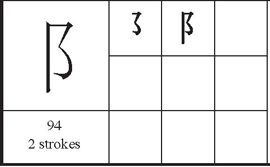
FÙ, mound. LEFT-EAR radical (33)
Fù was a picture of steps leading down from the mound. In form, “mound” and “city” (191, p. 39) are identical, but because of their positioning as part of characters, fù is called the “left-ear” radical and “city” the “right-ear” radical. Neither radical has anything to do, semantically, with organs of hearing.
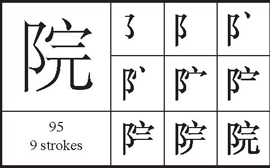
YUÀN, public building; courtyard [A] Yuán (89, p. 18) is used here to give the sound.
院子 yuànzi courtyard
医院 yīyuàn hospital L1

YUÁN, garden, park [A]
This is another character in which 元 gives the sound.
公园 gōngyuán park L3
园丁 yuándīng gardener, teacher
園

BÙ, a negative prefix for verbs and adverbs; NOT radical (95) [A] L1
Bù is bú before a word in the 4th tone.
不好 bùhǎo It ’s not very good; No good!
不很 bùhěn not very…
很不 hěn bù very un-…
不忙 bùmáng There’s no hurry; Take your time; Easy does it
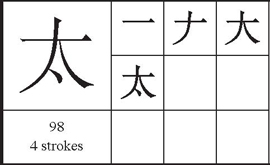
TÀI, extremely [A] L1
太忙 tài máng be too b usy
太太 tàitai married lady, wife [B] L5
田太太 Tián tàitai Mrs. Tian
太子 tàizi prince, crown prince
Distinguish from 大 (61), although etymologically they are the same word.

GĀO, be tall; to tower; family name. TALL radical (218) [A] L2
Karlgren says “picture of a high building, a tower with roof and windows” (Analytic Dictionary 308).
高大 gāodà be big and tall, be tall [B]
高中 gāozhōng high school
高矮 gāoǎi height (see frame 61, p. 13 on abstract nouns in Chinese)
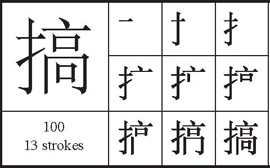
GǍO, to do, to make; to manage, to get; to purge [A] L5
搞鬼 gǎoguǐ tricks
搞好 gǎohǎo do well
搞笑 gǎoxiào funny

YÒU, again. RIGHT-HAND radical (35) [A] L3
A drawing of the right hand (compare “left hand,” 221, p. 45). 又 means “again” by sound-loan.
又不 yòu bù not at all ...
又高又大 yòu gāo yòu dà be both tall and big
又矮又小 yòu ǎi yòu xiǎo be both short and small
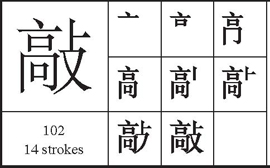
QIĀO, to rap on; to blackmail; (colloquial) to swindle, cheat [B] L4
The right-hand part, 攴, was a radical in the traditional system; it meant “to knock, to hit.” In 敲 it gives the meaning. Gāo (99, p. 20) suggests the sound.
敲打 qiāodǎ beat
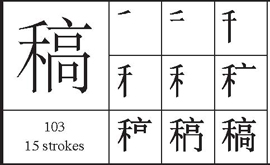
GǍO, stalk (of grain); draft, sketch; manuscript [C]
A sound-meaning compound. Gāo suggests the sound, while hé suggests the meaning.
稿子 gǎozi draft; manuscript; plan, outline [D]

YUÈ, moon, month. MOON/MEAT radical (118) [A] L1
月 is a picture of the moon. As an independent character, it means “moon.” But as a result of modern simplifications, two traditional radicals—“moon” and “meat”—which were identical in form have become one radical. “Meat” as an independent character is 肉 (1013, p. 203).
月亮 yuèliàng moon L3
月份 yuèfèn month
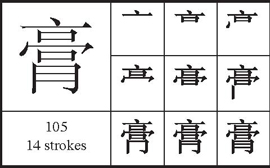
GĀO, ointment; fat; grease; be oily, rich, sleek [C]
The “moon/meat” radical—with the signification here of “meat”—gives the meaning. 高 gāo (99, p. 20) gives the sound.
膏药 gāoyào adhesive plaster
药膏 yàogāo ointment
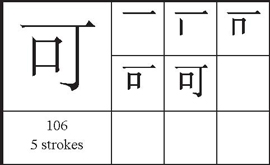
KĚ, may, can; to suit; certainly [A]
The origin of this character is unclear.
可笑 kěxiào be laughable [C] L6
可口 kěkǒu to “suit your mouth,” to taste good [D] L6
不可 bùkě should not
可心 kěxīn be satisfying, pleasing
可可 kěkě cocoa
可口(可乐) kěkǒukělè Coca (cola)
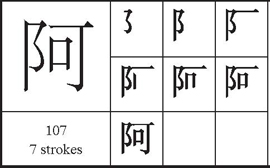
Ā, prefix for people’s names [B]
This character originally meant “slope.” “Mound” (94, p. 19) suggested the meaning, and kě (106, above) suggested the sound. As a prefix, it is used by sound-loan.
阿门 amén Amen (in prayer)
阿高 A-Gao (Old) Gao (our friend or acquaintance, Mr. Gao)

Ā; a sentence-final particle—for questions, exclamations, commands, warnings, reminders, emphatic pauses, enumerations, direct address, and impatient statements. [A] L3
Sound-loan, reclarified with “mouth.”
好累啊 hǎo lèi a (I’m) really tired!*
小心啊 xiǎo xīn a Be careful!
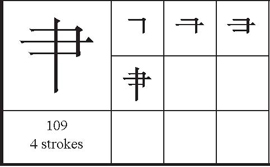
No pronunciation; radical (124), “top of
聿 yù.” 聿 yù was a picture of a hand holding the Chinese writing brush. 聿 yù, once the “brush” radical, is no longer a radical.

YUĒ, to say. SAY radical (104) [D]
Yuē has a stroke inside the mouth, perhaps to suggest the tongue moving. Learn to tell “say” 曰 from 日 “sun” (179, p. 36). In “say” (but never in “sun”) the inner stroke is usually incomplete (stops short of the right vertical stroke). Also, “say” is shorter and fatter than “sun.” Bookish.
子曰 zǐyuē Confucius said
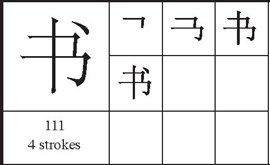
SHŪ, book; letter; document; to write [A] L1
Shū used to be brush over yuē, “say” (see frame, bottom right). Now, it’s pretty abstract.
手书 shǒu shū to write in your own hand; a personal letter
天书 tiān shū a book from outer space—abstruse or i llegible writing
情书 qíngshū love letter
書

JIÉ, seal (as in “seal ring”). SEAL radical (32)
The student should learn to tell the “seal” radical from the “right-ear” radical (191, p. 39). Like the “right-ear” radical, jié appears always at the right-hand side of characters (with one exception, where jié appears top-center). Seldom used independently.
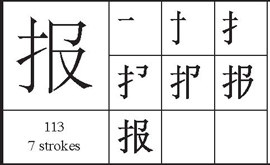
BÀO, to announce, report; newspaper; to requite [A]
The old form of bào meant “requite” because it was a picture of a man kneeling, in manacles, with a hand to mete out punishment. Other meanings by sound-loan.
小报 xiǎobào tabloid
报纸 bàozhǐ newspaper L2
報

MÁO, hair, fur, feathers; wool; mildew; semi-finished; gross (not net); a measure for dimes; family name. FUR radical (112) [A] L5
Máo is a picture of an animal’s pelt. Distinguish from 手 “hand” (27, p. 6).
毛发 máofà hair
毛巾 máojīn towel L5
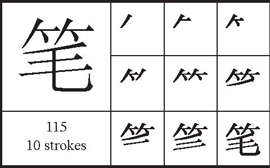
BǏ, brush, writing instrument [A]
笔 appears nicely to combine meanings, for the traditional Chinese writing brush is made of hair + bamboo. Note that the traditional form also makes sense.
毛笔 máobǐ writing brush [C]
笔心 bǐxīn pencil-lead; refill for ball-point pen
筆
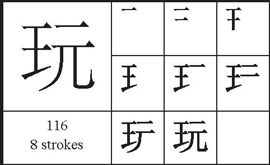
WÁN, to play, to amuse oneself [A] L2
A sound-meaning compound. 元 yuán (89, p. 18) suggests the sound. The “king” is undoubtedly a survival of the time when “king” 王 was an alternative form of the “jade” radical 玉 —toys being often made of jade.
玩笑 wánxiào a joke [C]
古玩 gǔwán antique
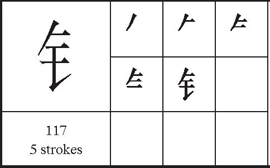
JĪN, gold, metals; family name. SIDE-GOLD radical (147)
The radical in over 200 characters, this form does not occur independently (see 218, p. 44, for the independent form of “gold, metals”). Often in characters for various metals or metallic objects.
钅
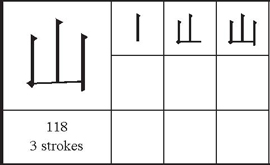
SHĀN, mountain. MOUNTAIN radical (60) [A]
山 is a picture. In old forms, it is clearly three peaks sticking up. 山 often occurs independently as a character and means “mountain” or “hill.”
山口 shānkǒu mountain pass; a common Japanese family name.
爬山 páshān mountain climbing L3
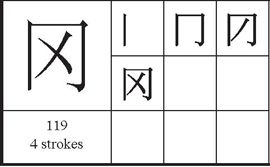
GĀNG, ridge [D]
In the traditional form (see below, this frame), the “X” inside of 冈 had “mountain” as part of it. That has been lost in the modern simplified form.
山冈 shāngāng low hill, hillock [D]
岡
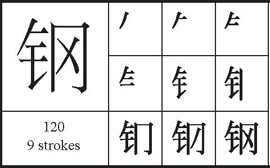
GĀNG, steel; GÀNG, to sharpen, whet [A]
This is a sound-meaning compound: 钅 “side-gold” (“metals”) for meaning, gāng (119, p. 24) for sound.
钢笔 gāngbǐ (modern) pen [A]
炼钢 liàngāng steelmaking
鋼

GĀNG, just now; exactly; only; to be firm, be hard [B]
刚才 gāngcái just n ow [A] L3
刚刚 gānggāng be exactly…; just now [B] L4
刚好 gānghǎo Perfect !
剛
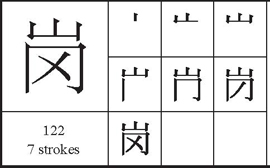
GǍNG, ridge; mound or hill; sentry [C]
岗位 gǎngwèi post L6
站岗 zhàngǎng stand guard
崗

GĀNG, main rope of a net; essential principle; discipline; authority [C]
The “silk” radical helps with the meaning. The right part suggests the sound. Original meaning might have been: rope made of silk.
纲要 gāngyao outline
纲目 gāngmù detailed outline(of a subject)
綱
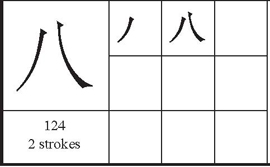
BĀ, eight. EIGHT radical (24) [A] L1
There are a number of common modern characters in which this radical appears in the form , so the student should learn both forms. The form here is the independent form.
王八 wángbā tortoise; (vulgar, abusive) cuckold
鸡巴 jība (abusive) dick
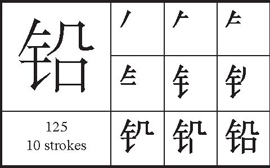
QIĀN, lead (the metal) [A]
The “side-gold” radical suggests that it is a metal.
铅笔 qiānbǐ pencil [A] L3
鉛

MǏ, rice; a family name. RICE radical (159) [A] L3
米 was originally a picture of rice growing in a paddy—some argue that the horizontal stroke represents the water that stands in paddies. Distinguish from 采 “sift” (620, p. 125), from 禾 “grain” (81, p. 17), and from 木 “tree” (80 p. 17). See next two items for mǐ as a phonetic.
大米 dàmǐ rice
米饭 mǐfàn cooked rice L1
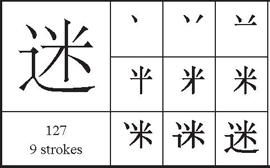
MÍ, to get lost; to get dirt in your eye; to develop an (unreasonable) passion for; fan, “bug” [B]
迷路 mílù lose one’s way, get lost L5
迷宫 mígōng labyrinth

MÍ, riddle [C]
(MN) “Get lost” in “words” = riddle
谜语 míyǔ riddle L5
谜底 mídǐ answer of a riddle
謎
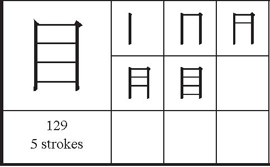
MÙ, eye. EYE radical (141) [A]
This character is a picture. Learn to distinguish the “eye” radical from the “small nose” radical 自 (619, p. 124).
书目 shūmù b ooklist, catalog of book titles
目中无人 mùzhōngwúrén be supercilious, haughty; consider no one worth your time
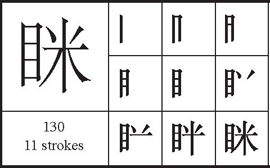
MĪ, narrow your eyes; (dialect) take a nap; MÍ, get into a person’s eyes (dust, dirt) [C] L6
The function of the “eye” on the left is obvious.
眯缝 mīfèng narrow (one’s eyes)
瞇

DĀO, knife. KNIFE radical (27) [A] L4 The form , seen in some combinations, is also classified as radical (27).
刀 is a picture. Distinguish it from 力 “strength” (11, p. 3).
刀子 dāozi knife [ B]
刀口 dāokǒu knife edge; a crucial point; incision
日本刀 rìběndāo katana (dagger, knife)
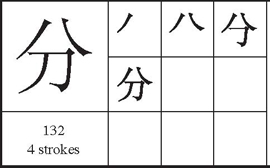
FĒN, to divide; a fraction; a very small part; FÈN, a component; a share, one’s lot [A] L3
The “eight” is a picture of something being cut in two by the knife. 分 is phonetic in several items, where it may give the rhyme (-en, -an, -in).
分手 fēnshǒu to part with somebody L6
分心 fēnxīn to distract somebody
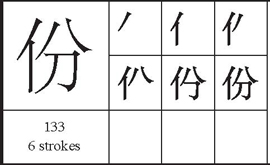
FÈN, share, portion; a measure for portions [B] L4
Compare with 分 (132, above).
份额 fèn’é share; portion
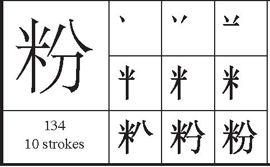
FĚN, dust, powder, rice noodle [B]
Face powder used to be made of rice. Fěn is a sound-meaning compound: “rice” for meaning, fēn (132, above) to suggest the sound.
粉笔 fěnbǐ chalk
粉末 fěnmò powder L6
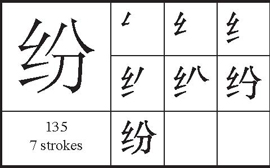
FĒN, be tangled, be confusing; be profuse [B]
The “silk” radical may help with the meaning. Fēn (132, p. 27) gives the sound.
纷纷 fēnfēn one after another; be numerous and confused L5
纠纷 jiūfēn dispute L6
紛
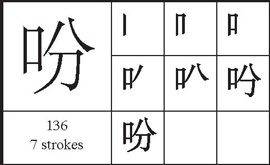
FĒN, first syllable of 吩咐 fēnfu, to give somebody an order (instruction), to tell somebody to do something [B]
For 咐, see 908, p. 182.

PÀN, to hope for; to look [B]
The “eye” radical helps with the meaning here. 分 (132, p. 27) gives, if imperfectly, the sound.
盼望 pànwàng look forward to L5
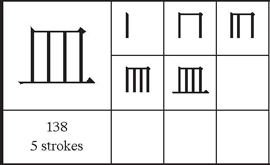
MǏN, dish. DISH radical (146)
A picture of a bowl. Distinguish from the “blood” radical 血 (1010, p. 203).
器皿 qìmǐn containers and untensils

PÉN, pot, basin, container [B] L5
A sound-meaning compound.
盆子 pénzi basin

BÈI, a cowrie; a family name. COWRIE radical (106) [D]
A cowrie is a small, yellowish-white shell “with a fine gloss, used by various peoples as money” (Century Dictionary). Cowries used to be money in ancient China. The “cowrie” radical appears in characters for value, money, business transactions, etc.
贝壳 bèiké shell L6
贝克汉姆 bèikèhànmǔ (David) Beckham
貝

PÍN, be poor, insufficient [C]
贫 looks like a meaning-meaning compound: “to divide” + “the cowries” (money) = “to be poor.”
贫穷 pínqíong poor
贫民 pínmín poor people; pauper
貧

BÀN, to act (in a play); disguise yourself as; make a face [B]
装扮 zhuāngbàn dress up
扮演 bànyǎn play the role
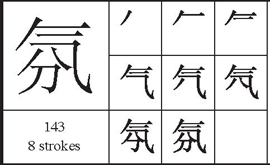
FĒN, atmosphere [C]
This character has 分 fēn (132) for sound and 气 “breath, vapors” (64, p. 13) for meaning.
气氛 qìfēn ambience L6
雰

LÌ, to stand; to cause to stand, to set up; to be standing: be upright, vertical; to exist, to live; immediate (right away, instant). STAND radical (126) [A]
独立 dúlì independent L5
中立 zhōnglì neutral
立刻 lìkè right away L5
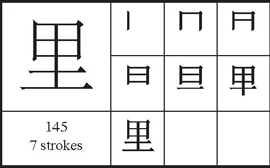
LǏ, village; li, a unit of distance (⅓ of an English mile); lining; inside, in. VILLAGE radical (195) [A] L1
A meaning-meaning compound: “land” + “fields” = “village.” Other meanings by sound-loan. Its meaning “inside, in” gives 里 the function of turning some nouns and pronouns into place-words. Consult a grammar (e.g., Chao 620-24).*
里边 lǐbiān inside
故里 gùlǐ hometown
裏 /裡
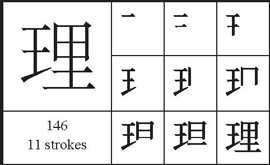
LǏ, grain (e.g., of wood); principle; reason, logic, truth; (by metonymy) natural science; to set in order; to speak to; to pay attention to [A]
理 originally meant “veins in jade” and was a sound-meaning compound.
理解 lǐjiě understand L4
理论 lǐlùn theory L5
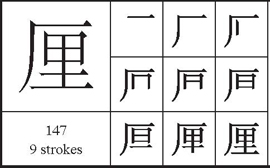
LÍ, a fraction, a smallest part; 0.33 millimetre; 0.05 gram; 0.667 square meters; a mill, one thousandth of a (Chinese) dollar (yuán); a unit of monthly interest—0.01%; a unit of annual interest—1% [B]
厘米 límǐ centimeter L5
釐
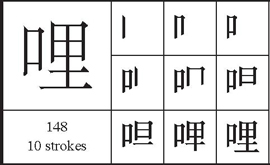
LĪ, LI, see below (B)
The mouth 口 at the side warns, as often, that the character is to be read for its sound value alone. 哩 lī is used to write such imitative vernacular expressions as 哩哩 啦啦 līlīlālā, “off and on, scattered,” and (as li) at the end of an obvious statement (“..., of course”) or after items in a list of examples, or to transliterate foreign words as 啫哩 (Jelly) 啦: see Pt. 2, p. 219a.
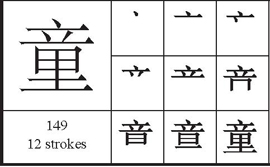
TÓNG, child; children; a family name [B]
童女 tóngnǚ maiden, virgin
童心 tóngxīn childlike innocence of an old man; playfulness of a young man
童话 tónghuà fairy tale L6
(MN) A child stands inside
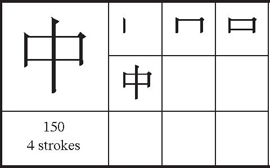
ZHŌNG, middle; Chinese; ZHÒNG, hit the middle, fit perfectly; be hit or affected by; MIDDLE radical (105) [A]
The downstroke through the center of the rectangle suggests “middle.”
中心 zhōngxīn center, core [B] L5
中立 zhōnglì “standing in the middle,” i.e., neutrality [D] L6
中国 Zhōnguó China L1

ZHŌNG, clock; a family name [A] L4
The “gold” radical here signifies some object made of metal, and the “middle” radical gives the sound: a sound-meaning compound.
十分钟 shífēn zhōng ten minutes
一见钟情 yíjiànzhōngqíng love at first sight
鐘
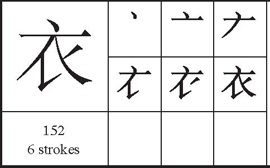
YĪ, gown. GOWN radical (161) [A]
This character is a picture. The gown’s sleeves and skirt can be seen clearly in older forms. As a part of characters, this radical often (not always) means that that character refers to an article of clothing.
毛衣 máoyī (wool) sweater [B]
大衣 dàyī overcoat

No pronunciation. Radical (89) “Top of 青” (see 249, p. 50).
See also the next character.
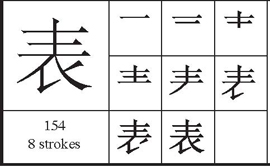
BIǍO, to show; be on the surface, be external; list, form; meter, gauge; watch (timepiece) [A]
Some say biǎo once meant “overcoat” and came to its other meanings by sound-loan—but more likely “overcoat” and “to show” are cognate words (the overcoat: the external coat).
手表 shǒubiǎo wristwatch [B] L2
(“watch” only) 錶
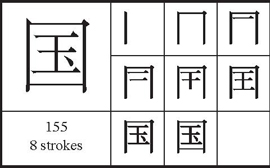
GUÓ, nation [A]
中国 Zhōngguó Chi na, the “Middle Kingdom” L1
国王 guówáng king [B]
中立国 zhōnglì guó a ne utral nation
美国 Měiguó the U.S.A.
國

YÁNG, sheep, goat; a family name. SHEEP radical (157) [A]
Yáng is a picture. The “eight” radical at the top gives the horns. Other forms in which this radical may appear, as part of characters, are 
小羊 xiǎoyáng lamb
山羊 shānyáng mountain goat
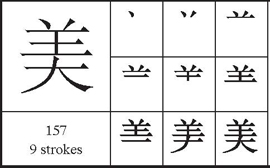
MĚI, be beautiful [B]
This character is supposed to be a meaning-meaning compound; one dictionary says, “If the sheep is big, it will be beautiful.” Plumpness in women has often been considered beautiful.
美国 Měiguó America, the U.S.A.
美好 měihǎo be fine, happy, glorious [B]
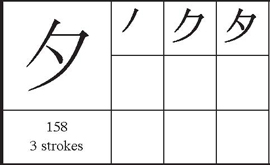
XĪ, dusk. DUSK radical (64) [D]
The character is a drawing of the moon, to suggest “dusk.” Learn to tell “dusk” from the “chip” radical 歹 (408, p. 82).
夕阳 xīyáng the setting sun L6
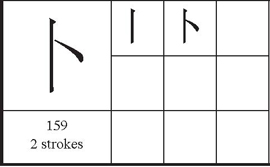
BǓ, to divine. BO, as in 萝卜 radish. DIVINE radical (16) [B]
In the Shang Dynasty (1751–1122 B.C.), the kings divined by scratching messages on tortoise shells. A professional diviner applied heat to the shell until it cracked, then read the cracks to divine. The “divine” radical is supposed to represent the divination cracks in the shell.

WÀI, outside; relatives of one’s mother, sisters, or daughters [A] L2
The “dusk” radical, and “divine.” The oracle crack appeared on the outside of the tortoise shell.
外国 wàiguó foreign country [A]
外表 wàibiǎo surface, appearance [D] L6

KÀN, to look at; KĀN, to look after, take care of [A] L1
A meaning-meaning compound: “hand” over “eye” to suggest “to look at.” Note that the “hand” radical is slightly altered. Distinguish “look at” from 着 (586, p. 118).
看中 kànzhòng to select, choose
看门 kānmén to act as doorkeeper

XĪ, west. COVER radical (166) [A] L3
Xī came to be the “cover” radical when, because of similarities in form, script-reformers put it together with a traditional “cover” radical. As a radical, it appears at the top of characters. It is a picture of a bird nest and originally meant “to nest.” “West” by sound-loan. Distinguish from 酉 the “wine” radical (474, p. 95).
西边 xībīan west side
西瓜 xīguā watermelon L2
西餐 xīcān Western-style food
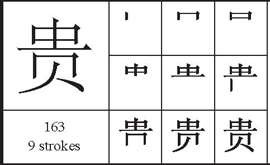
GUÌ, be expensive, precious [A] L2
Guì is a sound-meaning compound. The top part, no longer used as an independent character, gave the sound, and “cowrie” suggests the meaning.
可贵 kěguì be valuable, deserve commendation [D]
贵人 guìrén government VIP, (obsolete) concubine of the emperor.
貴
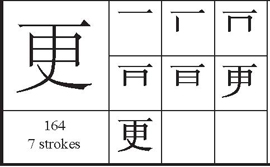
GÈNG, still more; GĒNG, to change; a “watch” (two-hour period of the night) [A] L3
The modern character is too much changed to make the explanation helpful.
更好 gènghǎo be better; even more
更快更高更强 gèngkuài gènggāo gèngqiáng Faster, Higher, Stronger
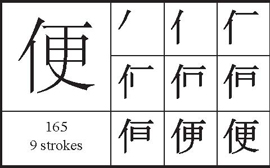
BIÀN, be convenient; PIÁN, the first syllable of piányi, be inexpensive [A] L5
小便 xiǎobiàn to piss, a piss [C]
大便 dàbiàn to shit, defecation [C]
便衣 biànyī street clothes, “civvies”; plain-clothesma

No pronunciation. “SIDE-SIGN” radical (87)
Pre script reform, this was a variant of the “sign” radical (899, p. 180). Consistent with the reformist principle “what you see is what you get,” it is now a separate radical. “Sign” in the sense of “signs from heaven” as well as “to exhibit, show.”
Distinguish from 衤, “side-gown” (290, p. 59), which has one more dot on the right side.

QIĚ, further [A]
Some say the character is a drawing of an ancestral tablet. Some say a chopping block to put sacrifices on, some say it is a picture of a penis. Originally it stood for a word meaning “ancestor” or “grandfather.” Now it is used by sound-loan. It appears as the sound element in a number of characters (see below), where it has the value zu or cu.
且慢 qiěmàn wait a moment
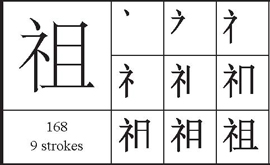
ZǓ, grandfather; ancestor; family name [A]
祖国 zǔguó fatherland [A]
祖父 zǔfù grandfather [C]

ZŪ, rent, to rent [A]; hire, lease
Rent traditionally was land rent and was paid in grain, hence the “grain” radical in this character.
租房 zūfáng tenement
租户 zūhù the lessee, tenant
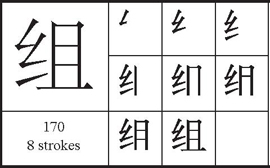
ZǓ, to organize; a unit of organization, such as a section or department [A]
且 is the sound element here, for zǔ. “Silk” is for meaning (build up threads).
组织 zǔzhī organize, organization
组员 zǔyuán member
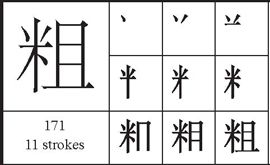
CŪ, be coarse (not fine) [B]
且 works as phonetic here, for cū. The “rice” radical works for the meaning.
粗心 cūxīn be car eless, thoughtless L4
粗人 cūrén rough/uncouth person
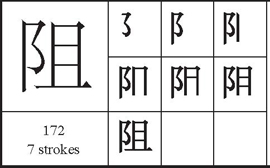
ZǓ, to block, to obstruct [C]
The “mound” radical (“left ear,” (94, p. 19)) is intended to help with the meaning. 且 gives the sound zu here.
阻力 zǔlì obstruction; (physics) resistance, drag [C]
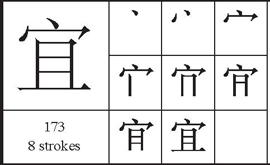
YÍ, be appropriate [A]
The character is a picture of “the sacred pole of the altar of the soil, behung with ... meat” (Karl -gren, Grammata Serica Recensa 21). It meant “sacrifice to the earth god.” It is used for “be appropriate” by sound-loan.
便宜 piányi be inexpensive [A] L2
宜人 yírén pleasant, delightful

YÀO, to want, to ask for; be “wanted,” be important, essential [A] L2
要人 yàorén important person (usually a government official)
要不 yàobù otherwise, or else, or [C]
要好 yàohǎo be on good terms, be friends; be eager to imp rove yourself [C]
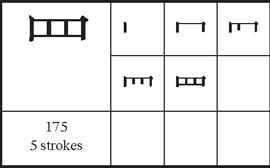
WǍNG, net. NET radical (145)
A picture of a net.
 is not seen as an independent character. It appears as a radical in about 20 modern characters, always at the top.
is not seen as an independent character. It appears as a radical in about 20 modern characters, always at the top.

TÓU, the head; a suffix used to form nouns and noun-phrases; a bulb (of garlic); a measure-word for certain animals [A]
(MN) The “big” radical (61, p. 13) in tóu should be thought of as the drawing of a man and the two dots as an indicator: “the top part,” i.e. “head”
木头 mùtou wood; a fool [B] L5
頭

MǍI, to buy [A] L1
The simplified form is a stylistic abbreviation of its traditional counterpart. The pre-reform character (see below) had an eye watching the cowries (money), making a pretty good meaning-meaning compound.
买方 mǎifāng buyer
买进 mǎijìn to buy; purchase
買

MÀI, to sell [A] L2
In the pre-reform character, the “ten” radical at the top was 士 shì “knight” (see 35, p. 8)—perhaps a supervisor or assistant working with the seller to make sure the seller got it right. Although this is more of a mnemonic than a real etymology.
买卖 mǎimai business [B]
卖国 màiguó be a traitor [D]
(MN) Sell ten things you have bought
賣
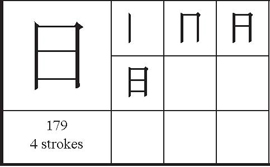
RÌ, sun. SUN radical (103) [A] L1
Rì is a picture. Distinguish “sun” from “say” 曰. See 110, p. 23.
日子 rìzi day, date; period of time; life, livelihood [A]
日元 rìyuán Japanese yen (unit of money). [B] (日 here is short for 日本 Rìben, Japan. 本: see 308.)
日报 rìbào daily newspaper [C]
Note that in slang, 日 can mean the F word (both literally and metaphorically)
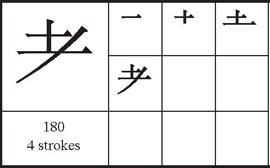
No pronunciation; radical of “old” (see next) and three other characters. OLD radical (92)
This seems to be an abbreviated form of 181, below, which is explained as a picture of an old man with long hair and a cane (analyzable as “earth-left-ladle”).
Three of this radical’s compounds have to do with age or seniority.

LǍO, be old. [A] L3
老二 lǎoèr second son or daughter, (slang) penis [A]
老人 lǎorén old person; “old folks”—grandparents (or old parents) [B]
老小 lǎoxiǎo young and old, family
老太太 lǎotàitai old lady, my ma [B]
老头儿 lǎotóur old coot [B]
老头子 lǎotóuzi old fart, (colloquial) my “old man” (= husband)
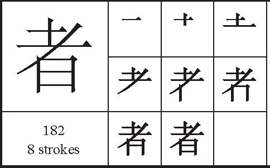
ZHĚ, a suffix to verbs: verb + zhe means “a person who... .” Compare with English suffix “-er.” [A]
者 gives the sound in several characters (see the following few items).
老者 lǎozhě an old guy, old guys
作者 zuòzhě author L4

QUǍN, dog. SIDE-DOG radical (69)
As a radical, 犭 appears at the side of characters (about 60 characters). 犬 (638, p. 128) also means “dog” (they were the same radical before script reform). 犭 appears often in characters for medium-size animals (pig, wolf, monkey, otter, cat—even lion) and for such qualities as ferocity, cruelty, courage, impetuosity.

ZHŪ, pig [A] L4
The “side-dog” radical helps with the meaning; 者 (182, above) is there for the sound.
猪排 zhūpái pork chop
猪肉 zhūròu pork
豬
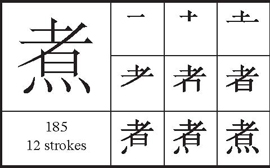
ZHǓ, to boil, cook up [B] L5
“Fire-dots” for meaning, 者 (182, p. 37) for sound.
煮器 zhǔqì boiler
煮饭 zhǔfàn cook rice, cook a meal

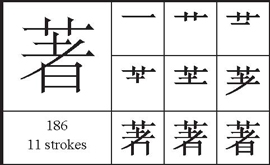
ZHÙ, to spread out, to display, be displayed; to author [B]
著者 zhùzhě writer, author
名著 míngzhù masterpiece
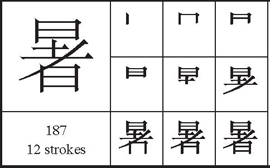
SHǓ, summer, summer heat [B]
The “sun” radical 日 gives the meaning. 者 (182) may help with the sound.
暑假 shǔjià summer vacation
暑热 shǔrè summer heat
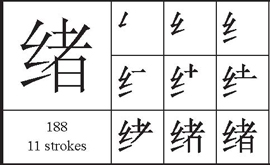
XÙ, end of a thread; clue; to be together; succession; dynasty; profession [B]
“Silk” 纟 is there for the meaning.
绪论 xùlùn introduction
緒
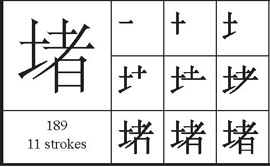
DǓ, to stop up; to stifle, be stifled; (bookish) wall; (often metaphorically: “a wall of spectators” [meaning many]); a measure for walls [B]
The “earth” radical 土 is the meaning part of this compound.
堵塞 dǔsè stop up L6
堵车 dǔchē traffic jam L4

SHǓ, an office, a government office; to arrange a piece of work; to handle as a deputy; to put your signature to [C]
Karlgren sees “net”  as the meaning component and 者 zhě (182, p. 37) as the sound component in this character.
as the meaning component and 者 zhě (182, p. 37) as the sound component in this character.
署名 shǔmíng signature
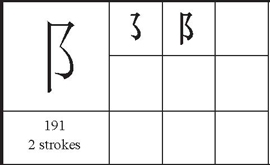
YÌ, city. “RIGHT-EAR” radical (34)
Learn to tell this radical from the “mound” radical (94, p. 19). In form, “mound” and “city” are identical, but because of where they appear as part of characters, “mound” is called the “left-ear” radical and “city” the “right-ear” radical. Neither character means “ear.”

DŌU, all; DŪ, metropolis, capital [A] L1
In the sense of “metropolis,” this character is a sound-meaning compound; “city” gives the meaning, and zhě (182, p. 37) once gave the sound. In the sense of “all,” it is used by sound-loan.
都是 dōushì all
首都 shǒudū capital L4
都市 dūshì city

GǑNG, clasped hands. CLASP radical (51)
Gǒng is a picture of two clasped hands. Not now in use as an independent character. Distinguish from 艹, the “grass” radical (16, p. 4) and from
廿 (194, below)
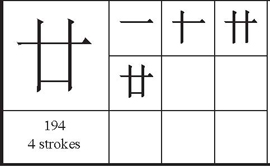
NIÀN, twenty. TWENTY radical (93)
This character is formed of two “ten” radicals written together. This character is normally read aloud simply as
二十 èrshí —“twenty.”
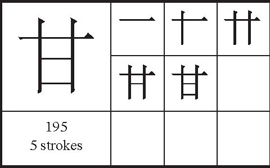
GĀN, to taste sweet; a family name. SWEET radical (135) [C] (MN)
廿 being a picture of the mouth, the horizontal line being something sweet inside
甘甜 gāntián sweet, luscious

HUÒ, perhaps; or [A]
Originally, this character meant “nation.” As “nation,” it combined meanings: “lance” (for the army) + “mouth” (for a language) + “earth.” (“Earth” got corrupted into the “one” radical.) Compare with the traditional form of 国 (155, p. 32). 或 = “perhaps” and “or” by sound-loan. 或许 huòxǔ maybe; perhaps L6

FĀNG, basket. BASKET radical [15]
The “basket” radical is a picture. The basket appears to be turned on its side, with the open top to the right. Not in modern use as an independent character.

PǏ, mate; one half of a pair [B] L5
一匹马 yìpǐ mǎ a horse, one horse
匹夫 pǐfū ordinary man; “dummy,” stupid fellow
国家兴亡, 匹夫有责 guójiāxīngwáng, pǐfūyǒuzé Rise and fall of a nation rests with every one of its citizens

SÌ, four [A] L1
This is an arbitrary symbol. Memorize it.
四书 sìshū “The Four Books,” the “core classics” of Confucianism

WǓ, five [A] L1
(MN) Tilted king with a stick
五十 wǔshí fifty
十五 shíwǔ fifteen
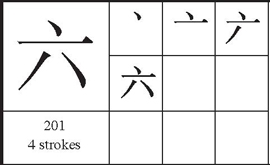
LIÙ, six [A] L1
六书 liùshū the six categories of Chinese characters (see pp. xii–xiv)

QĪ, seven [A] L1
The student will want to distinguish 七 from the “ladle” radical 匕 (41, p. 9).
七夕 qīxī the seventh night of the seventh lunar month—the one night of the year, according to myth, that the legendary lovers “The Cowboy” and “The Weaver Girl” get to spend together
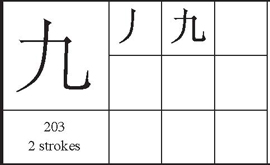
JIǓ, nine [A] L1
九天 jiǔtiān “Ninth Heaven,” the highest of heavens (the Western world has “seventh heaven”)
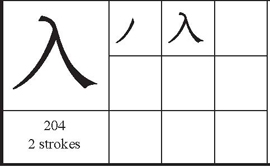
RÙ, to enter [B]
Distinguish “enter” from “person” 人 (4, p. 1). As independent characters, they have different pronunciations and meanings—but as radicals they are grouped as one in modern dictionaries.
入口 rùkǒu entrance [D] L4
入手 rùshǒu put your hand in, get started, make a beginning [D]
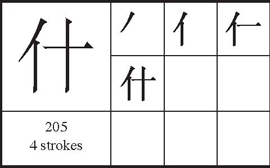
SHÉN, the first syllable of shénme what? [A] SHÍ, miscellaneous
什 is ubiquitous as shén; as shí, rarely seen.
什锦 shíjǐn assorted
甚
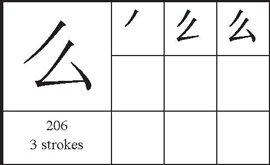
ME, the second syllable of shénme what? [A]
什么 shénme what? [A] L1
麼

ZHUŌ, table [A]
The “tree” radical at the bottom gives a clue that this character stands for a word referring to some object made of wood. Suggest remembering as “divine,” “sun” and “wood.”
桌子 zhuōzi table [A] L1
书桌 shūzhuō writing desk

QÍ, be weird [B]
Qí is said to be a meaning-meaning compound.
(MN) “Big” + “be able” = “be weird”
好奇 hàoqí be curious, be interested in oddities or just many things [C] L5
好奇心 hàoqíxīn curiosity (state of mind, not a thing)
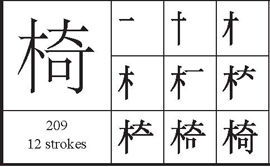
YǏ, chair [A]
Yǐ is supposed to be a sound-meaning compound: qí (208, above) for sound, “tree” for meaning (= something made of wood).
椅子 yǐzi chair [A] L1
摇椅 yáoyǐ rocking chair
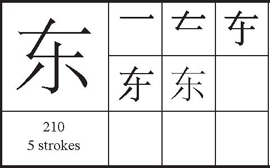
DŌNG, east [A] L3
Originally a picture of a bundle, used for “east” by sound-loan. Later scholars said the traditional form (see below) was “the sun tangled in the branches of a tree, hence ‘east’—which of course was not correct.” In Han-Ying Cidian, 东 is one of 11 “left-over” characters, not classified under a radical.
东边 dōngbiān east side
东家 dōngjiā host
東
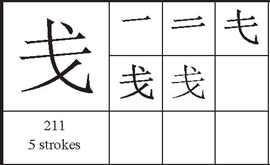
JIĀN, be thin
Jiān originally meant “be fierce, be cruel” and was a meaning-meaning compound: two lances to suggest ferocity. It means “be thin” by sound-loan.
戔
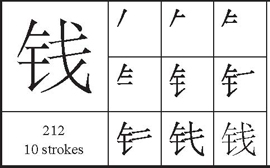
QIÁN, money; a family name [A] L1
The “side-gold” radical (117, p. 24) gives the meaning, and jiān (211, above) suggests the sound.
九分钱 jiǔfēn qián 9 cents
金钱 jīn qián money [D]
有钱人 yǒuqiánrén rich man
錢
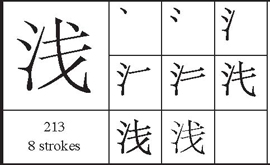
QIAN, be shallow, superficial; be mild [A] L5
This would appear to be a sound-meaning compound, like qián “money” (212, above), but the meaning of “thin” may also be involved in the sound-element 戋: “thin water.” Compare with 212, above.
深浅 shēnqiǎn depth
浅色 qiǎnsè light-color
淺

GÈ; a “measure,” used to enumerate nouns in the construction “number + gè + noun”; be individual [A] L1
三个 sāngè three . . .
个人 gèrén each person; oneself (B) L5
个子 gèzi stature (B) L4
个儿 gèr stature; each one (C)
个个 gègè all of ’em
個















 are variant forms of this radical. In early texts it means “fish guts” and may have been a picture. On “heavenly stems,” see
are variant forms of this radical. In early texts it means “fish guts” and may have been a picture. On “heavenly stems,” see










































































































































































































